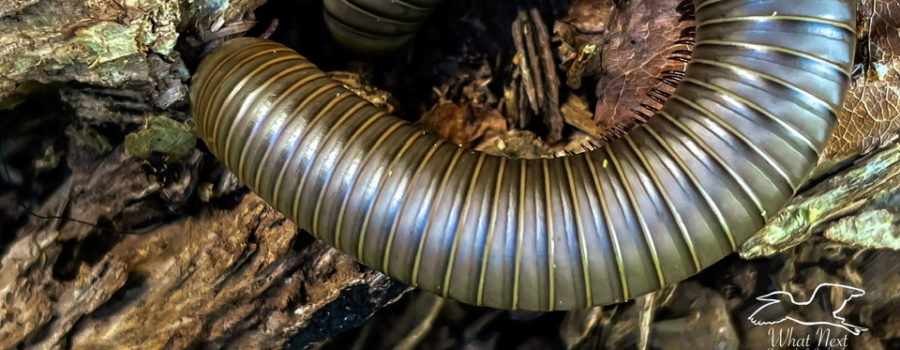How Many Legs Does the Interesting American Giant Millipede Have?

Hint, it’s not actually a thousand like the name millipede indicates… In actuality, the longest American giant millipede (Narceus americanus) ever measured had 375 pairs of legs (for a total of 750). Each segment has two pairs of legs, and a new segment is added each time they molt, so both length and number of legs increase as the animal ages. Interestingly, many people think that millipedes are insects, but they are actually arthropods, so they are related to animals like crawfish, lobsters, and shrimp. Remember that to be classified as an insect an animal has to have three body segments and only six legs, so that totally rules out millipedes who have many segments and hundreds of legs!

The millipede in these photos was found on one of my afternoon nature walks. I was taking pictures of some flowers and scuffed up the leaf litter on the forest floor to discover the millipede. It was a short encounter since it’s main goal was to get back under the leaf litter. I try not to harass my subjects, so I didn’t do anything to stop it, but I did get in a few shots before it disappeared again. The American giant millipede is a fairly common millipede in the eastern United States and Canada. It is most often found under leaf litter (like in this case), rocks, downed branches, and even occasionally under animal carcasses. It has a firm, chitinous skin that helps to protect it, but despite the skin, these guys can dry out very easily, so they prefer to be in moist, protected areas. Like many invertebrates, millipedes hibernate throughout the winter, only re-emerging from their burrows when the weather starts to warm up. These millipedes are fairly long lived creatures with the oldest one known living for over eleven years. They don’t even reach reproductive maturity until about two years of age. They feed mostly on decaying wood, leaves, and roots, but will also eat fruit and deer droppings when available. They’re also coprophagic, meaning that they will eat their own feces to gain nutrients that may not have been digested the first time around. Although they may sometimes be found under carcasses, they do not eat decaying animals, but rather they use them like branches or rocks to provide protection .

The American giant millipede is unique among millipedes in a couple of ways. First, like most millipedes, they secrete a noxious substance when threatened, but unlike the others, the substance they secrete is not a hydrochloric acid derivative. Instead, these millipedes secrete benzoquinones, which can still burn and discolor human skin but the burn will be much less severe. Secondly, the American giant millipede lays only one egg at a time, which the female will incubate until it hatches. Most other types of millipedes will lay multiple eggs at a time, and give no parental care at all.

Like most millipedes, the American giant millipede is pretty much a solitary animal. They do communicate with each other, mainly through the use of pheromones, for the purpose of reproduction. When mating, the male will crawl along the back of the female. She will arch her front segments backwards to receive his spermatophore, a packet of sperm that she will store for use as she lays her eggs. Some females will mate with only one male, while other will mate with multiple males. Males routinely mate with multiple females during any one breeding season. Once laid, the egg will take between 3-10 weeks to hatch depending on temperature and humidity factors.

American giant millipedes are very important environmentally, in helping to recycle nutrients , especially calcium, out of detritus and back into the soil. They also help to speed up the decaying process and allow access to various bacteria and fugal organisms that also help to break things down. They may not be the prettiest or cutest creatures on earth (nor are they the ugliest), but they do provide a very valuable service and have little to no negative impacts.





Recent Comments